Walsall to Lichfield Railway Line
The railway line, then called the Walsall to Wichnor branch, was opened on April 9th 1849, and connected Walsall to Wichnor Junction, where it joined the Midland line to Burton On Trent. Stations were built at Walsall, Rushall, Pelsall, Brownhills, Hammerwich, and Lichfield. The line was leased by John McLean for a 21 year period, but he gave up the lease in 1861, and the line transferred to the LNWR. The passenger service closed on January 18th 1965.
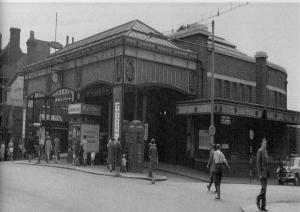
Front entrance to Walsall Station, in Park Street

Walsall Station Booking Hall, off Park Street.
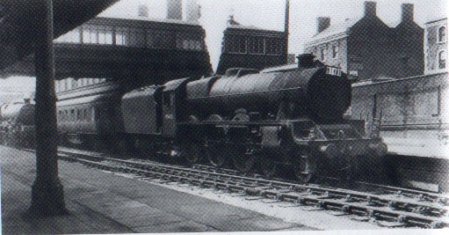
Pines Express waiting to depart from Walsall Station.
The Railway line left Walsall, going under Park Street and Wisemore. On the outskirts of the town,at the junction to Cannock, stood Ryecroft engine sheds, where the steam locomotives allocated to the Walsall area were kept and maintained. Ryecroft shed was of red brick construction, with a saw tooth northlight roof, and spanned 12 sets of parallel tracks, or roads as was the railway terminology.
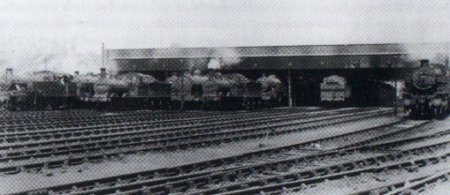
All Railway sheds were issued with a shed code number, and locomotives were fitted with a cast plate bearing the code of their home shed. Ryecroft was allocated code number 3C, which was screwed to the smoke box door of each locomotive, immediately below the engine serial number. Steam traction was replaced at Ryecroft, by diesel multiple units (DMU) in 1957.
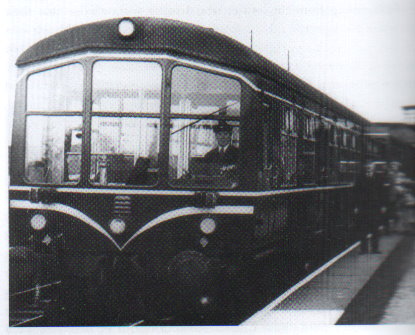
One of the DMU’s allocated to Ryecroft shed. Photographed at Shenstone on the Lichfield to Birmingham service in 1957.
Ryecroft engine sheds closed in 1965 and were demolished in 1970. Eventually Walsall Council purchased the land, and landscaped it into what is known today as Mill Lane Nature Reserve.
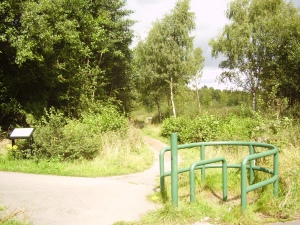
Main entrance to Mill Lane Nature Reserve.
Leaving Ryecroft engine sheds behind, the Lichfield line ran alongside Ryecroft cemetery and crematorium. The crematorium is not there today , and all the buildings have been taken down.
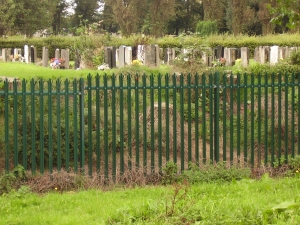
Ryecroft cemetery taken from the track bed
The line then crossed Station Road in Rushall, via a gated level crossing, operated by an adjacent signal box.
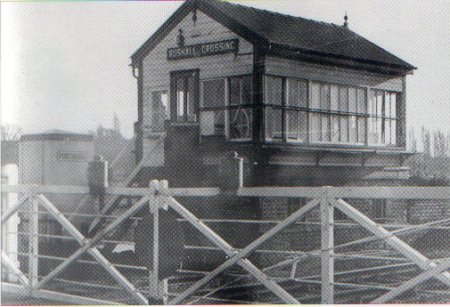
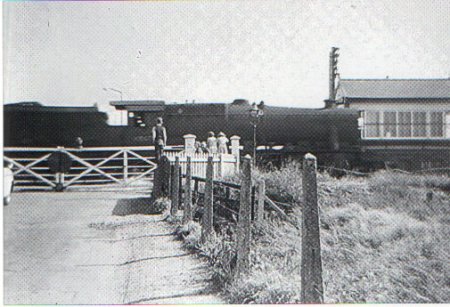
An 8F engine with possibly a freight train heading towards Lichfield. It was just past this crossing where Rushall station was located. At the present time I cannot find any information about this station, other than it existed, and that it closed in 1909.
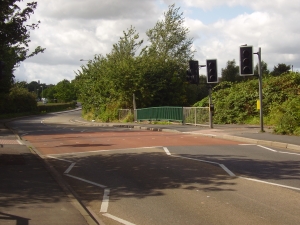
Station road Rushall today, at the point where the level crossing was. This is now an extremely busy road, and would today, be impossible for a level crossing, as was in the 1950’s.
Running alongside Fordbrook the line crossed the meadows heading towards Pelsall.
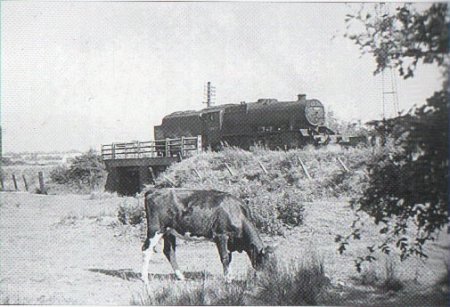
Clearing the meadows area, bought the rail traffic to Heath End, where after going under Heath End bridge, there was a branch line feeding Leighswood Colliery, Victoria Brickworks, and Barnett and Beddows Brickworks at Stubbers Green in Aldridge
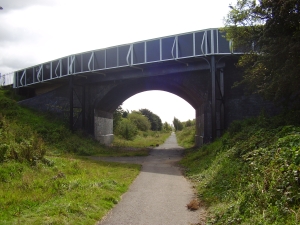
Heath End bridge
The main line however carried on, and crossing over Fordbrook Lane, entered Pelsall Station.

Bridge over Fordbrook Lane
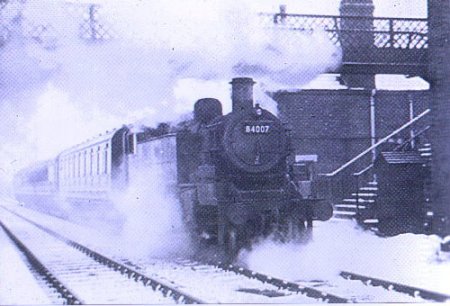
A passenger train in Pelsall station on a winters day.
While the train is standing in Pelsall station we will take a look down the Leighswood branch line. Opened on November 14th 1878 it was a single track line, worked with a token system, which only allowed one train on the line at any one time. The line was controlled from Leighswood signal box,who issued the unique, red painted token, which gave access to the line. Passing through Shelfield, the railway crossed the Four Crosses and Lichfield roads in a deep cutting, on the Walsall side of the Spring Cottage Public House.
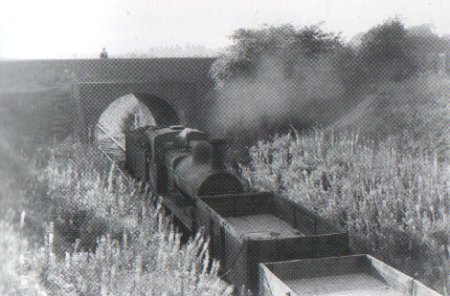
This picture was taken between the bridges on the Four Crosses and the Lichfield Roads.
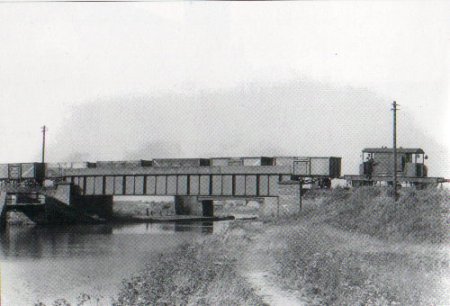
Train from Leighswood Colliery crossing the canal.
The Collieries closed in the 1930’s and from that date the railway’s just served the Brickworks
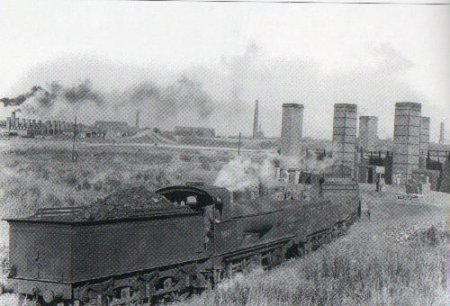
Train entering Atlas Brickworks
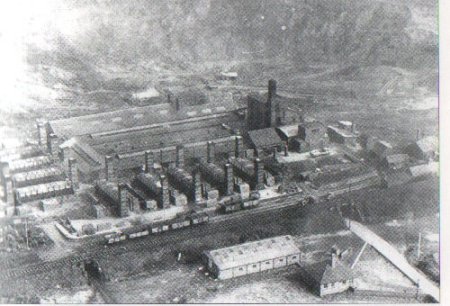
Ariel view of Atlas Brickyard.
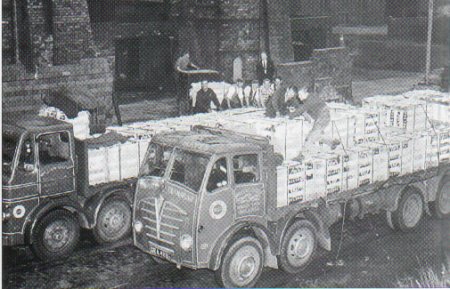
As the railway’s started to decline, heavy lorries began to take over the brick haulage industry, and the branch line finally closed in 1964. The cuttings were filled in and houses built on the land. The only evidence remaining, is part of the blue brick, railway bridge wall, in Lichfield road Shelfield.
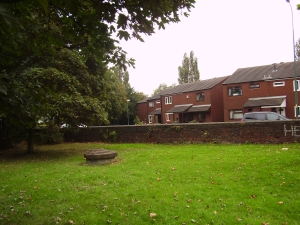
Remains of the bridge in Lichfield Road Shelfield.
We now return to Pelsall station to continue our journey towards Lichfield. The Pelsall Station Master lived on the station in a company owned house. As well as his normal station duties, he had overall responsibility for the 24 hour operation of the nearby Norton Junction Marshalling yard.
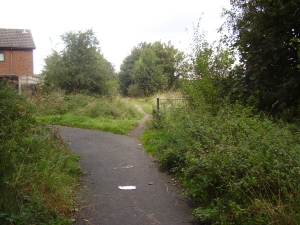
The site of Pelsall Station, as it is today. The 10 mile Mercian Trail walk known as the Timberland Trail passes at this point.
After leaving Pelsall Station, the line passed under a farmers bridge, which gave access to Railswood farm
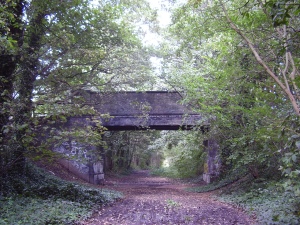
A short distance further along the line, was Ryders Hayes crossing, complete with the signal box, which also controlled the point system, which allowed the goods traffic which came from Walsall, entry into Norton Junction, which was situated to the left of the main line.
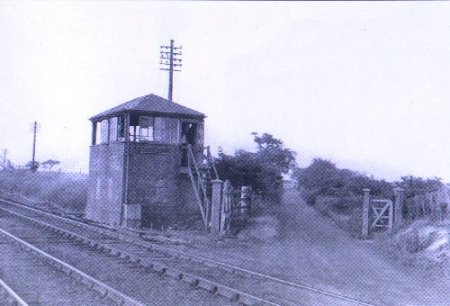
Ryders Hayes crossing and associated signal box

Ryders Hayes crossing as it is today.
On passing Norton Junction, there was a link from the yard feeding the main line towards Lichfield. The single line from Walsall Wood Colliery also entered the marshalling yard at this point.
Upon clearing the complex track network of Norton Junction, the engine driver was faced with the distant signal for entry into Brownhills station.
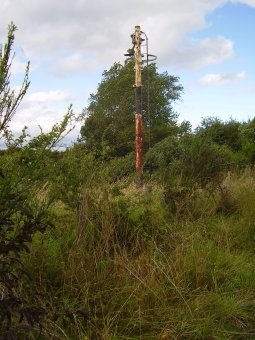
The remains of the distant signal steel post still stand today
Gradually climbing to embankment level,the railway ran parallel with Pelsall road, the houses in Clifton Avenue, over a farmers bridge, Clayhanger Lane bridge, and over the Wyrley and Essington canal by the Swan public house.
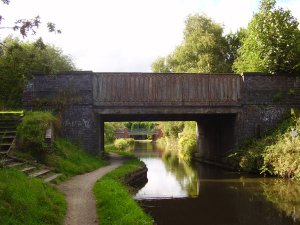
The bridge by the Swan public house. The new bridge on the Pelsall Rd can be seen in the background.
At this point the embankment gradually reverted back to ground level, and just before the line went under the old Midland railway line, there was a farmers level crossing to Swing bridge pig farm.
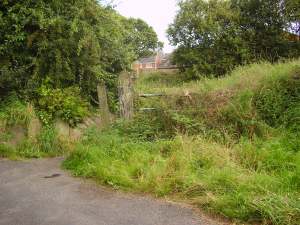
Remains of the farmers crossing to Swing bridge pig farm.
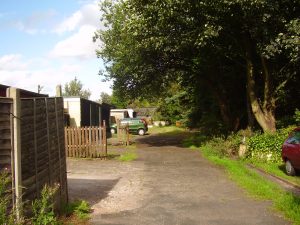
Track bed today by farmers crossing, the remains of the Midland line bridge is in the far background.
Going past Brownhills signal box and the canal sidings, the line went under Brownhills bridge and entered Brownhills station.
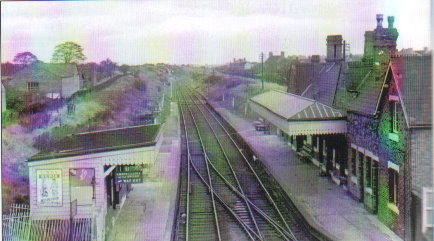
Brownhills station looking from the bridge towards Lichfield.
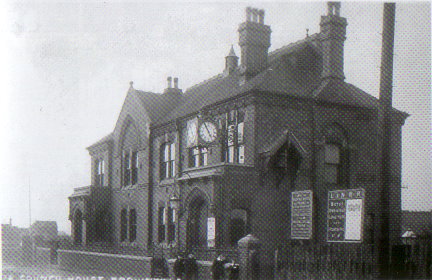
The entrance to the platform was down a steep path to the right of Brownhills Council house as seen in the picture. Note the brick pillar.

Site today where the platform entrance was, the brick pillar is all that remains. The track bed is completely overgrown with trees and shrubs.
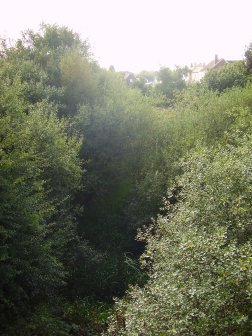
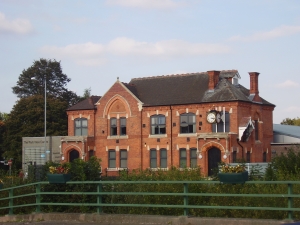
The Council house today. Although the main building remains the same, it as been extended for the use of the local health centre and public library. All council work is now done in Walsall Civic Centre.
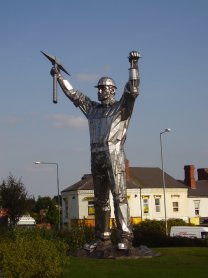
Jigger the stainless steel miner now stands guard on the bridge, and welcomes people to the High St.
When the railway was taken over by the LNWR in 1861, the company ran a small fleet of double-decked buses to take passengers onwards to Chasetown and Chase Terrace
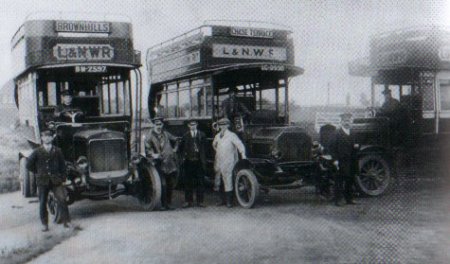
These buses were garaged down by the canal sidings at Brownhills. The buildings were later taken over by Charles Ferrie a local business man.
Leaving Brownhills the line remained in a deep cutting, skirting Holland park and passed at the bottom of Barnetts lane, which is now a cemetery. As the railway approached the A5 trunk road, still in the cutting, it again crossed the Wyrley and Essington canal. This time however the waterway went over the cutting by means af an aquaduct.

A short distance from the aqueduct was the bridge under the A5 trunk road.
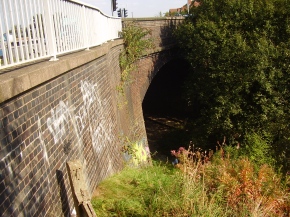
immediately past this very busy trunk road was Anglesey sidings. These sidings were installed to collect and distribute coal which had been mined at the Norton Canes, and Cannock Chase Coalfields. There was a branch line linked to the collieries via Chasewater. After the coal traffic ceased the sidings were used by Charringtons, to hold and distribute heavy fuel oil, for industrial and domestic use. Large holding tanks were erected, and the company started operating in 1966, with a throughput of three trains per week, each train carrying one million litres of oil. January 1965 saw the last passenger train to use the line, with freight trains running until 19th march 1984. The line was then closed between Anglesey sidings and Ryecroft. The section between Anglesey sidings and Lichfield however, was kept open, to enable oil freight trains to continue with large deliveries to Charringtons. Due to the infrequent traffic, the line was converted to single track working. The last delivery of oil by railway was on May 15th 2001, and the company finally closed on April 31st 2002.
The area was cleared, and a haulage company specialising in container logistics, now operates from the site.
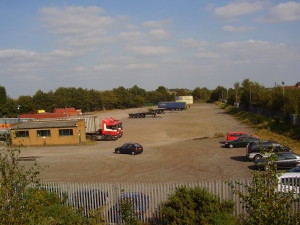
Today’s picture of the old Anglesey sidings.
Leaving the sidings the railway continues towards Lichfield. Leaving the cutting, the terrain changes to another embankment, and swiftly arrives at the point where the recently constructed BNNR motorway, crosses at a near right angle. The BNNR, AKA the M6 Toll, is at a lower level than the railway line. Consequently the road builders cut through the embankment and constructed a steel and concrete bridge to span the gap, ensuring continuity of the line.
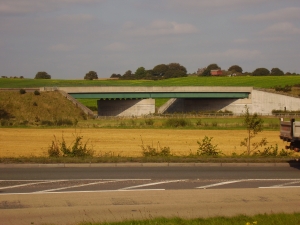
Bearing left the railway then headed for Hammerwich station.
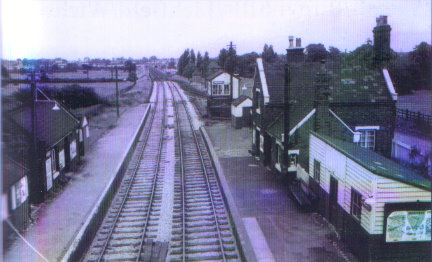
Leaving Hammerwich in its wake, the line negotiated the A461 at pipe hill.
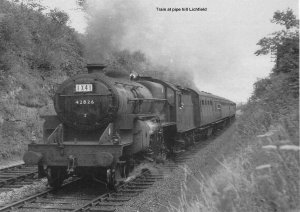
Train at Pipe Hill Lichfield
The railway line then curved towards the left heading for Fosseway level crossing.

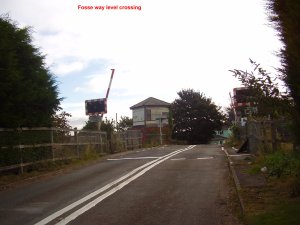
Fosseway barrier controlled level crossing.

The redundant signal box still stands next to the Fosseway level crossing.
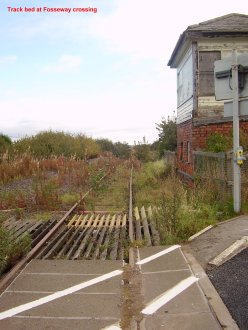
The track bed at Fosseway crossing looking towards Lichfield. Mother Nature as started to reclaim the land.
The line starts to climb to embankment level from here to Lichfield. On the approach to the Lichfield boundary there is a new bridge being constructed through the embankment, to accommodate the new Lichfield bypass road.
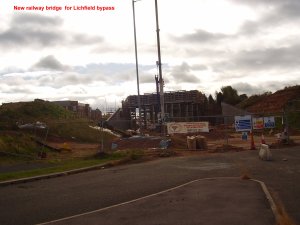
A short distance onwards towards Lichfield, the old Walsall line meets up with the current Birmingham line, and crosses the Birmingham road.
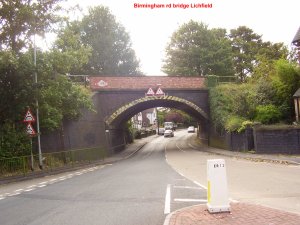
A little further towards the city centre the line crossed over Upper St John Street.
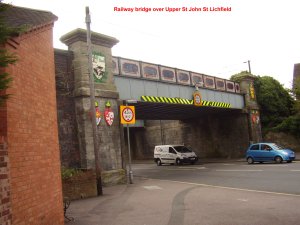
Another view of the bridge showing that it was in fact constructed with two seperate steel sections, spanning Upper St John Street.
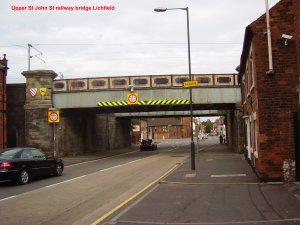
This bridge was also the entry point into Lichfield City Station.
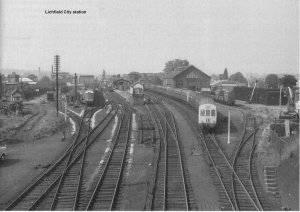
Lichfield City Station in the 1960’s.
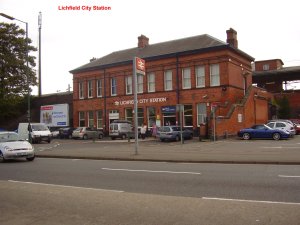
Lichfield City Station, main entrance, today.
July 15, 2010 at 8:06 am |
Fascinating reading, brilliantly mixing the old and the new. A very enjoyable half hour, thanks for you time. What an interesting stretch of railway this is.
July 16, 2010 at 8:50 pm |
Thanks Adam for your kind comments. I enjoyed following the old line where access permitted, and comparing the old with the modern day. Im glad you enjoyed reading the article. Kind regards Godfrey Hucker (oakparkrunner)
November 13, 2011 at 10:01 pm |
Very interesting reading, found your article as have walked along the fosseway stretch today and wondered where it went. I remember the very long coal trains going along there when I was much younger.
November 24, 2011 at 3:42 pm |
Thanks for all your pictures and information.I used to travel from Pelsall station to New Street every day to work (by steam and later diesel units) also occasionally to Lichfield and Burton,I remember once going on a steam excursion from Pelsall to Alton Towers (train was packed) Happy days.
February 12, 2012 at 10:39 am |
excellent information and pictures. Im not a rail/train enthusiast per sa but enjoy photography. Having recently moved to South Lichfield i was looking for subjects to photograph and came across this site by accident. An enjoyable journey through the past which prompted me to enjoy a morning photographing Fosseway Level crossing which is just five minutes drive from home. Seeing the landscape battling to reclaim the land and the ivy growing up the building structure was great for photography and my imagination soon conjoured up images of trains in yesteryear thundering through the crossing.
February 13, 2012 at 1:04 am |
well researched, interesting to relate to what was then common place areas in a permanent, everlasting childhood,seemingly never to change, thanks for taking time. any further information in addition to published documents by jack haddocks on sat only running of pines, and relief pines express to engine exchanges with saltley supplied engines running to next exchange at bath, whilst saltley service original manchester engines in readiness for reverse leg working from walsall?
March 4, 2012 at 5:11 pm |
VERY GOOD ARICLE ON WALSALLS RAILWAYS PAST AND
PRESENT
April 16, 2012 at 1:36 pm |
Very good, informative article. I used the Brownhills – Lichfield route daily 1959/64,travelling to school at King Edwards. I particularly remember the Hammerwich station that always had well maintained flower beds. We had steam engines in the mornings & diesels in the afternoons. The local Working Men’s Clubs organised summer excursions from Brownhills Station. I came across this site while watching a TV program about the Fosse Way & remembered the Fosseway crossing. Such a shame the trackbed was allowed to such a state, it would have been great for a tramway!
July 16, 2012 at 1:19 pm |
Thanks for the effort you have put in to this, I remember the old Walsall station with exterior its glass canopy on to Park st, and its beautiful wood paneled booking hall, with W H Smith bookstall, at the time of its demolition the glass canopy was rebuilt in Walsall arboretum, not sure if it is still there though.
September 28, 2012 at 6:30 am |
The 8F is heading towards Walsall The box is behind the loco on the up line towards Ryecroft Junc
January 12, 2013 at 11:04 pm |
I’m too young to remember any of the older pictures myself, but the two pictures of the Ryders Hayes crossing are definately being viewed in different directions (just in case anyone thought it was a like-for-like pic)
The old photo is showing the crossing facing in the direction of Brownhills. That road to the right used to lead to a farmers house and barn. (The barn used to be viewable from miles away – it was that big, and in the middle of nowhere) The whole area where the barn and house used to be has since been open cast coal-mined and there is a large lake there now. However the distant tree on the left hand side of the pic, seen between the signal box and the telegraph pole is still there to this day. When the area was mined, they didn’t touch the area where this tree is, for some reason…?
The newer photo has been shot facing Bloxwich. The house you can see was built somewhere between 1990-1995. The road on the right of the pic joins Ryders Hayes lane. (Which can just about be seen through the trees)
Spent many youthful days on the section of track bed between shelfield and clayhanger. Commonly known as ‘pelsall comp’, ‘railswood’, ‘the ackers’, ‘the big hill’, ‘the double-bridges’, ‘Clayhanger bridge’ and ‘the pig farm’ (thats in order, going from heath end to clayhanger) Anyone from my era will remember those names I’m sure…
August 27, 2013 at 10:18 pm |
Coming under the heath end bridge from walsall, just after the bridge on the right hand side were a couple of railway sidings where many a coal railway truck were parked for what seemed like years at the time, just after the sidings there was the junction that went to Shelfield direction over the devils drop bridge, literally yards after the junction you came to heath end railway footbridge (cast iron construction and as memory serves i think railway sleepers were used for the steps and gantry walkway), just after the footbridge there used to be a signal box ( spent some time in there as very young lad pulling the levers when signals man said it was time to pull them…..had my first cup of tea out of white enamelled tea urn in there in front of the cast iron stove…memories just returned as typing this). after the signal box there may have been a water tower (memory blurred on that) then just railway till the bridge over Fordbrook lane and then onto Pelsall station.
Post note – I lived right next door to the gulley that lead to heath end footbridge in victor street (Heath End) in the early sixties.
September 6, 2014 at 10:22 am |
Well researched and written Godfrey, really enjoyed reading it. Have passed your blog onto my friends at the CTC
October 1, 2014 at 6:18 pm |
superb , as a walsall boy now living in Lichfield right by Fosseway and walking almost every day along some of the pitcures you have taken with the dog i often wondered where the line went when i got to the signal box and turned back ,, and it today i find out it leads back home to Walsall .. superb
October 3, 2014 at 3:39 pm |
i was born in shelfield 1978 i have always been intrested in dissused railways especially hte walsall to lichfield one. As a kid i used to ride my pony along that dissused line i loved following it seeing where it branched of to other places i found it so fasinating i always new there used to be a railway through shelfield as a kid walking home from junior school i used to look at that wall on the lichfield road and say to my mom that used to be a railway bridge i could also tell by the cut of the land on the field by the catholic school my mom said i was been silly but years and years later i finaly find out there was indeed a railway brilliant. fantastic blog i love it.
October 14, 2014 at 7:12 pm |
Hi
The 8F on Rushall Crossing is Walsall bound
November 2, 2014 at 8:57 am |
Well done. As a new resident to Aldridge Village I found the site fascinating , and look forward to your newsletters.
Will follow the stations reopening Plans with special interest now.
Thank you for the time and effort you evidently have used to get such a good website
January 18, 2017 at 9:03 pm |
Hi do you know who owns this track bed now is it network rail or another body please
January 18, 2017 at 9:05 pm |
Hi do you know who owns the track bed now is it network rail or another body
January 19, 2017 at 4:42 pm |
Sorry do not know but I would assume network Rail as nothing as been built on.
February 5, 2017 at 3:56 pm
Hi, really interesting site!
I was involved with a railway reopening in south wales, before moving to Birmingham three years ago..i work in Brownhills now, and knew I could “smell” an old railway!!!!!
By the way, old railway property passed into the hands of BRB, a subsidiary of the old BR property division before it split into rail track.
January 28, 2017 at 3:47 pm |
Hi Jane, Currently the track from Pelsall to Brownhills is maintained by Railway Paths on behalf of Network Rail but we are campaigning to get it adopted by Sustrans for use as a leisure greenway. Follow us at http://www.backthertrack.org.uk
January 28, 2017 at 3:50 pm |
Sorry typing error, that should be
http://www.backthetrack.org.uk/
October 1, 2018 at 10:08 pm |
railway line needs reopening,to take the road traffic off the a460/a5 and pelsall road,and for the residents of hammerwich who have no public transport using the village Could be a park and ride at Anglesey sidings/newtown bridge ,Compulsory purchase of land owned by \\\\\\\\\\\\\\\\\\\\\\\\\\quattro if possible
October 3, 2018 at 9:42 pm |
the road should have been the a461 not the a460,sorry my mistake.